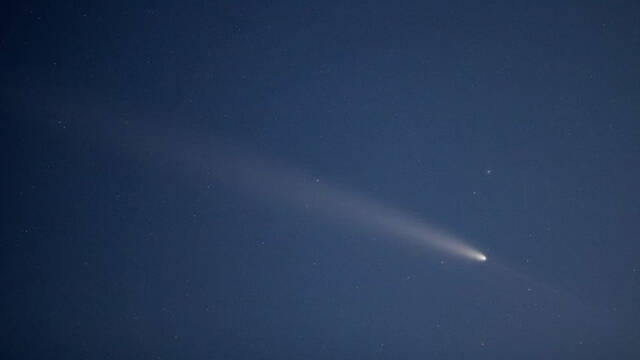https://staging.triblive.com/local/regional/no-time-to-wait-once-in-a-lifetime-comet-still-visible-in-western-pa/
No time to wait! Once-in-a-lifetime comet still visible in Western Pa.

If you look up at the night sky, you might be able to catch a glimpse of a rare, ancient comet — as long as you’re looking in the right spot.
The Tsuchinshan-ATLAS comet, which has been visible to the naked eye this week in Western Pennsylvania, will once again put on an astral display Friday night once it gets completely dark.
It can be seen by looking to the west where the sun sets, according to Kerry Handron, special events and outreach coordinator at Allegheny Observatory in Pittsburgh.
If the western horizon is clear, she said, the comet will be visible when it get completely dark until around 9:45 p.m.
“To the left of sunset, you’re going to see Venus … just to the right of where the sun sets [is the star] Arcturus,” she said. “Straight between them is [the] comet.”
It’s the fuzzy dot with a tail, Handron said.
The three — Venus, Arcturus and the comet — make a triangle in the sky, said Sandhya Rao, professor of physics and astronomy at the University of Pittsburgh.
“Once you know where it is, it’s easy to spot with the naked eye,” Rao said. “It takes a little bit of care.”
Viewing the comet through binoculars or a camera or phone set to a several-second exposure will help, similar to how people viewed the northern lights recently, according to Handron.
She was able to get iPhone photos of the comet on Tuesday night.
The comet will be visible 15 minutes later each day as it moves farther from the sun and gets higher in the sky.
“Weather is by far the biggest driver,” Handron said, as there need to be clear skies in the west.
Don’t wait!
There’s little time to dally to get a view of this rare celestial phenomenon. The comet is expected to fade from the view of earthlings in about a week or two, Rao said.
Initially, astronomers believed the once-in-a-lifetime comet wouldn’t be back for another 80,000 years, as that’s how long it takes to orbit the sun. According to NASA, though, the comet’s path may take it out of the solar system altogether.
“The orbits of comets are continuously revised as new observational data becomes available,” NASA said.
The comet has already reached its closest point to the sun, according to Handron.
“What we’re seeing now is the comet on its way out,” Handron said. “It’s going to get harder to see with the naked eye, especially if you don’t know where to look for it.”
Handron said by the end of October, the comet will be able to be seen with a small telescope, and she believes students at the observatory will be able to see it until mid-November using its 24-inch telescope.
“I think people with big telescopes will be watching it for quite awhile, but it’ll get dimmer and dimmer,” she said.
A rare sight
Though Rao said she’s seen comets before — including Halley’s Comet in 1986 — the experience doesn’t become any less astounding.
Halley’s Comet has an orbital period of 76 years, and it will return in 2061, according to NASA.
“Sighting a comet is rare. A lot of the comets, they might destroy themselves,” Rao said. “They also have to be close enough to the Earth so we can spot them.”
All comets were formed when the solar system was formed, according to Rao.
“(The) composition of these comets is basically what existed at the time of the formation of the solar system,” she said. “We know they existed at the basis of the solar system — all comets are really, really old.”
The Tsuchinshan-ATLAS comet was discovered last year by a NASA team, Handron said.
“There have been so many things this year, from the eclipse, to auroras to the comet, that are so accessible to everyone,” Handron said. “I think it builds a connection with the sky in a way that you don’t always have.”
Even for experienced astronomers, Rao said seeing a comet is awe-inspiring.
“It’s exciting because it wakens the public to things that are up in the sky rather than down on their phones all the time,” Rao said.
“To look at something that nature has up there for us, it’s exciting for everybody — professional astronomers to little kids.”
Copyright ©2025— Trib Total Media, LLC (TribLIVE.com)
